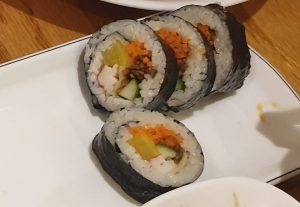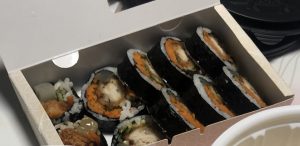My favorite Korean dish, Kimbap
As an international student studying abroad at Emory, I usually go back home in Korea during vacation. I spend valuable time together with my family and friends and when it comes time to leave for the upcoming semester, my mom asks me what I want to eat for my farewell dinner. Every time I am asked about choosing the menu, Kimbap has always been my choice of dish without hesitation.
Kimbap is a traditional Korean rice roll wrapped with seaweed including a variety of ingredients. The direct translation just makes sense, as Kim means seaweed and Bap means rice. While Kimchi has been the all-time favorite dish for Koreans, Kimbap also put its name on the list of the national dish for its popularity that comes from having the unique sentiment of the people. It captivated the Koreans with fast serving and high nutrition to meet the so-called ’hurry-hurry’ mentality and the tendency to make more of health. I have been eating Kimbap since I was a child and it has become the signature menu of our family because all the family members loved my mom’s special Kimbap that was quite different from the classic one. Instead of using white rice slightly seasoned with sesame oil and salt, she used rice fried with Kimchi to make the dish more spicy and tasty. Every time I went on a school picnic or family trip, our family sat together on the kitchen table the night before and rolled the kimbap together with my mom’s fried Kimchi rice. By doing so, we could have the family time to share our daily lives and feel connected to one another. Every time I went on a school picnic, I was a popular guy because my mom’s kimbap tasted so good. I gladly shared it with my friends and felt excited just to see them eating deliciously. Even though I could not eat my fill, my mind was full of a precious memory and sincere love of my mom and family. Kimbap is more than just a simple delicacy. It not only has the power to unite our family both in physical and spiritual ways, but also makes me feel nostalgic for my youth and the love of my family.
Kimbap is my favorite dish not only because of its great taste and nourishment, but also for its convenience and variety. Kimbap has the perfect blend of cooked rice and various ingredients including yellow pickled radish, ham, carrots, spinach, egg and fish cake. The more I chew Kimbap, the more flavor I get from this mixture of nutritious fillings. Just by eating Kimbap, I can get all the demanding nutrients for my body like carbohydrates and proteins. In Korea, I can get Kimbap as easily as I can get sandwiches in America. Plus, it only takes about a minute to roll Kimbap, so I believe there is nothing more convenient than this food. The last thing I like about Kimbap is that there are a variety of variations depending on what kind of fillings you put in. Bulgogi, Tuna, cheese, and pork cutlet Kimbap are the most popular ones in Korea. Each variation tastes completely different, so people can choose a certain type of Kimbap of their own taste and enjoy it. Being recognized for its benefits, Kimbap recently started to find its way into the hearts of many foreigners as well. I once visited a Korean restaurant in the United States to eat Kimbap and found out that half of the customers were not Koreans. They were people from all different countries who just came to enjoy Korean cuisine including Kimbap. I felt a sense of satisfaction and pride to see these people who were fascinated with the Korean food saying that this is because it is healthy and tastes good at the same time.
This popularity arouses the curiosity about the history of Kimbap that kind of looks similar to Sushi and in fact, many of my foreign friends asked me about the origin of the food. The history of Kimbap is quite debatable and I want to introduce two main beliefs shared by a majority of Koreans. First, some people claim that Kimbap has its origin in Japanese influence during the wartime. Japanese people, who enjoyed eating sushi rolls called Norimaki, may have affected Koreans to develop Korean style sushi roll, Kimbap. Others believe that Kimbap originated from Korean food Kimssam, a rice wrapped with seaweed. Our ancestors may have evolved Kimssam into a more nutritious and fancy dish which is now called Kimbap. I personally think that it is not a single belief, but both ideas influenced the evolution of Kimbap. I cannot deny the fact that Koreans were influenced by Japanese about their life style in general during the war time, so food would not be an exception. However, the origin of Kimbap is deeply rooted as it contains the unique characteristics of Korean cuisine. This distinction is what makes me still proud of Kimbap and the Korean cuisine.

<the classic kimbap>

<pork cutlet kimbap>

<Me on a picnic with Kimbap>
Recipe:
- Prepare Kim, cooked rice seasoned with sesame oil and salt, and the fillings including yellow picked radish, ham, carrots, spinach, egg, and fish cake.
- Put Kim first and place cooked rice evenly on top.
- Place the ingredients on the rice.
- Roll Kimbap and cut it into bite-sized pieces.
- Enjoy it!

Hae-Rim, this is a very informative post. I’ve learned a lot about kimbap, its various ingredients and flavors, popularity, its advantages over other dishes, and its history and development. Even though you’ve discussed in detail about kimbap, there’re a few areas I hope you’d touch upon in the essay, in response to the journal prompt. I’d encourage you to elaborate upon kimbap’s significance for you, particularly as you do not have the luxury of eating your mom’s kimbap as often as you want now, studying and living abroad. How do you feel when American friends discuss kimbap in front of you? How would you react to questions about Korean cuisine? Do you see kimbap or your mom’s particular version as crucial to your self-identity? Why or why not? The other thing I was looking for in your blog post is a photo of yourself or family (see prompt). I also wish you’d provide some information about why kimbap is the Korean national dish, not kimchi, bibimbap, bulgogi, etc.